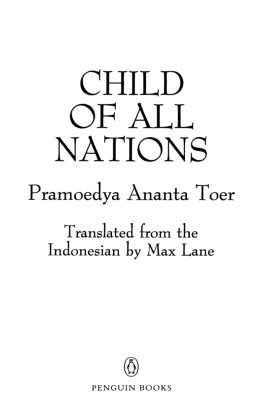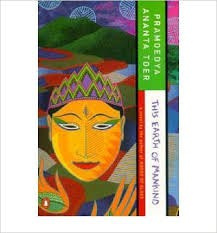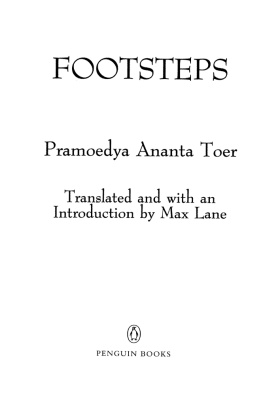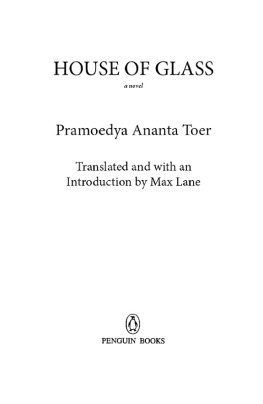PENGUIN BOOKS
CHILD OF ALL NATIONS
Pramoedya Ananta Toer was born on the island of Java in 1925. He was imprisoned first by the Dutch from 1947 to 1949 for his role in the Indonesian revolution, then by the Indonesian government as a political prisoner. Many of his works have been written while in prison, including the Buru Quartet (This Earth of Mankind, Child of All Nations, Footsteps, and House of Glass) which was conceived in stories the author told to other prisoners during his confinement on Buru Island from 1969 to 1979.
Pramoedya is the author of thirty works of fiction and nonfiction. His novels have been translated into twenty languages. He received the PEN Freedom-to-write Award in 1988 and the Ramon Magsaysay Award in 1995. He is currently under city arrest in Jakarta where his books are banned and selling them a crime punishable by imprisonment.
Max Lane was second secretary in the Australian embassy in Jakarta until recalled in 1981 because of his translation of Pramoedyas Buru Quartet.
PENGUIN BOOKS
Published by the Penguin Group
Penguin Group (USA) Inc., 375 Hudson Street, New York, New York 10014, U.S.A.
Penguin Group (Canada), 10 Alcorn Avenue, Toronto, Ontario, Canada M4V 3B2 (a division of Pearson Penguin Canada Inc.)
Penguin Books Ltd, 80 Strand, London WC2R 0RL, England
Penguin Ireland, 25 St Stephens Green, Dublin 2, Ireland (a division of Penguin Books Ltd)
Penguin Group (Australia), 250 Camberwell Road, Camberwell, Victoria 3124, Australia (a division of Pearson Australia Group Pty Ltd)
Penguin Books India Pvt Ltd, 11 Community Centre, Panchsheel Park, New Delhi 110 017, India
Penguin Group (NZ), cnr Airborne and Rosedale Roads, Albany, Auckland, New Zealand (a division of Pearson New Zealand Ltd)
Penguin Books (South Africa) (Pty) Ltd, 24 Sturdee Avenue, Rosebank, Johannesburg 2196, South Africa
Penguin Books Ltd, Registered Offices: 80 Strand, London WC2R 0RL, England
First published in Australia by Penguin Books Australia Ltd 1984
First published in the United States of America by William Morrow and Company, Inc. 1993
Reprinted by arrangement with William Morrow and Company, Inc.
Published in Penguin Books (U.S.A.) 1996
23 25 27 31 30 28 26 24 22
Copyright Pramoedya Ananta Toer, 1979
English translation copyright Max Lane, 1991
All rights reserved
Originally published in Indonesian by Hasta Mitra Publishing House, Jakarta, 1980.
THE LIBRARY OF CONGRESS HAS CATALOGUED THE HARDCOVER AS FOLLOWS:
Toer, Pramoedya Ananta, 1925
[Anak semua bangsa. English]
Child of all nations/Pramoedya Ananta Toer; translated from the Indonesian by Max Lane.
p. cm.
Translation of: Anak semua bangsa.
ISBN: 978-1-101-61532-4
1. IndonesiaHistory17981942Fiction. I. Title.
PL5089.T8A25 1993
899.22132dc20 933516
Printed in the United States of America
Set in Bembo
Except in the United States of America, this book is sold subject to the condition that it shall not, by way of trade or otherwise, be lent, re-sold, hired out, or otherwise circulated without the publishers prior consent in any form of binding or cover other than that in which it is published and without a similar condition including this condition being imposed on the subsequent purchaser.
CHILD
OF ALL
NATIONS
Pramoedya Ananta Toer
Translated from the
Indonesian by Max Lane

I NTRODUCTION
We fought back, Child, as well and as honorably as possible.
T hese were the words that ended Pramoedya Ananta Toers novel This Earth of Mankind, the first in a quartet of which Child of All Nations is the second. This Earth of Mankind was indeed a story of people fighting back, of resisting the worst of colonial oppression and greed.
It was also a gripping story of remarkable characters caught in the cultural whirlpool that was the Dutch East Indies of the 1890s. Because Pramoedyas vision extends far beyond parochial politics to reach for more universal human concerns, it is a bitter irony that, in 1965, he was arrested by Suhartos junta, and his entire library, including research and notes assembled over many years, were burned to ashes. He was jailed, without trial, for fourteen years. Denied access to writing materials, he kept his literary vision alive by recounting his stories to other prisoners. Only in 1975 was he permitted the facilities to commit his novels from memory to paper.
A year after his release from Buru Island concentration camp in 1979, This Earth of Mankind was published in Jakarta as Bumi Manusia. Soon after, its sequel Anak Semua Bangsa (Child of AllNations) was published. Both novels became best-sellers in Indonesia, as reviewers hailed Pramoedyas return to the nations literary life. However, in May 1981 both books were banned in Indonesia. The government accused the books of surreptitiously spreading Marxism-Leninismsurreptitious because, they claimed, the authors great literary dexterity made it impossible to identify actual examples of this Marxism-Leninism. Later in the year students from the University of Indonesia were arrested and expelled when they invited Pramoedya to speak on campus. One of the publishers of Pramoedyas books, Yusuf Isak, was imprisoned for over three months, without being charged. Pramoedya himself and Hasyim Rahmam, Yusufs partner in the publishing house Hasta Mitra, were repeatedly interrogated.
In This Earth of Mankind Minke is an eighteen-year-old Javanese, the first to be educated in an exclusive Dutch school in Surabaya. Striving for his own personal and intellectual development, he is drawn into the more immediate and dramatic struggle that faces his formidable native mentor, and then mother-in-law, Nyai Ontosoroh. Sold as a girl to a wealthy Dutch businessman by her ambitious father, Nyai had become acquainted with the true character of the colonial system early in life, and fought back at it with vengeance. After her corrupt and insane Dutch master is murdered, she rises to restore and control his business, Boerderij Buitenzorg. Minke, on the other hand, has been spoiled by the system. He has received an elite Dutch education. He is attracted to Dutch ways by the apparent superiority of the West, such as the modern achievements of electricity, machines, photographs, and books.
Minkes struggle, sparked off by his association with Nyai, becomes essentially against himselfagainst his integration into, and identification with, the colonialists civilization. Nyai Ontosoroh is self-taught; she has never been to an elite Dutch school, nor any school, except that of life itself. Yet she proves herself again and again to be capable of both defending her principles and self-respect, and imparting to Minke knowledge and understanding that he would never learn at school. Nyai Ontosorohs dignity is evidence of an alternative and superior civilization developed in spite of rather than because of Dutch colonial authority.
The separate strugglesMinkes against his illusions about Western values, and Nyais against their brutalizing effectsare complicated and intensified by their coming together. They are brought together by Nyais Eurasian daughter, Annelies, whom Minke loves and marries. Minke moves into Nyais mansion to live with Annelies. Anneliess deep and unqualified love for Minke is an attempt to resolve her own complex contradictions. Annelies is not legally Nyais daughter and, after Anneliess Dutch father dies, she reverts to being the property of his far-off Dutch relatives. Nyai and Minkes personal struggles are put aside as they fight (unsuccessfully) to protect Annelies from being taken to the Netherlands.











